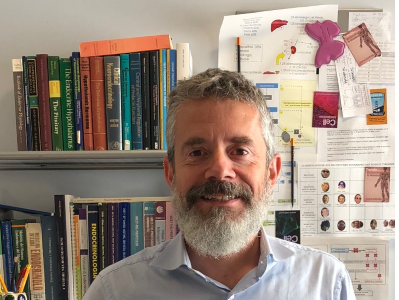Modena draws up the new guidelines on male Osteoporosis

The new European guidelines on male osteoporosis were drawn up in Modena and Leuven, Belgium. At the recent congress of the European Academy of Andrology, held in Budapest from 11 to 13 October 2018 professor Vincenzo Rochira of Unimore, endocrinologist of the University Hospital of Modena, Hospital of Baggiovara, in fact presented the guidelines on the health of bone in males, the result of an international cooperation with the research group of the University of Leuven, Belgium, directed by professor Dirk Vanderschueren. The guidelines were recently published on the international journal Andrology( https://onlinelibrary.wiley.com/doi/10.1111/andr.12470 ) and are available on the website of the European Academy of Andrology ( http://www.andrologyacademy.net/library.aspx?id=11 ).
The guidelines were presented a few days before the world day on osteoporosis, scheduled by the World Health Organization on 20 October ( http://www.worldosteoporosisday.org/events/2018/wod-giornata-mondiale-osteoporosi ). The purpose of the guidelines is to provide recommendations on the diagnosis and treatment of male osteoporosis, based on up-to-date and validated knowledge of the currently best available scientific evidence in international journals. The guidelines are useful to make the diagnosis and treatment processes consistent and standardised, by adapting them to the top standards as to ensure the best performance and treatments available.
Osteoporosis is a clinical condition in which the skeleton is subject to loss of bone mass and resistance, due to nutritional, metabolic or pathologic factors. The skeleton is therefore subject to a higher risk of pathologic fractures, as a consequence of the decrease in bone density and changes to bone microarchitecture. In males, the root causes of osteoporosis are hypogonadism (the reduction of hormonal levels of testosterone), primitive hyperparathyroidism, risk factors related to the lifestyle (nutrition, smoke, alcohol, inactivity), gastrointestinal pathologies and use of treatments such as cortisone-based drugs and cures for prostate cancer. Elderly males are the most affected age group, the over 70-year-olds in particular, although osteoporosis may even appear in younger people in the event of endocrine pathologies.
Although osteoporosis is less frequent in men than women, it may also affect men and particularly in old age. If not diagnosed and treated properly, osteoporosis may get more serious and lead to the fracture of the femur or the spine. Although it is well known that fractures in males are linked to a higher mortality than in females, the health of bone in male gender is seldom a focus of attention by doctors, due to its low frequency. Therefore, male osteoporosis is often undervalued, underdiagnosed, or detected after a substantial delay. This lack of knowledge limits the opportunity to prevent fractures and treat this pathology in males.
“These guidelines - professor Vincenzo Rochira explains – were drawn up by two research groups (Endocrinology of UNIMORE and of the University of Leuven) boasting a great expertise in the field of male osteoporosis upon request by the European Academy of Andrology, and are aimed to fill the gap in the field of the health of bone in males, as in literature there are not many guidelines addressing this pathology. Hypogonadism, that is the reduction in testosterone production (the male hormone) is among the root causes of osteoporosis in males. One of the most important aspects of these guidelines deals with the importance, inside the clinic, of some simple questions and manoeuvres that during the examination may address the doctor towards diagnosing this pathology, which is often neglected in males. For such reasons, these guidelines are mainly addressed to urologists or endocrinologists, who are often consulted by male patients for health issues linked to hormone production.”
“It is a new and extremely important goal for the endocrinology school of Modena – professor Manuela Simoni of Unimore, Director of the Complex Endocrinology Structure, stated – which for years has been leading the research in physiopathology of the loss of bone mass in males, and since the early 2000 has been one of the first centres in Italy to deal with male osteoporosis in the clinical field.”
At the Hospital of Baggiovara, a 1st and 2nd level outpatient consultation for the diagnosis and treatment of osteoporosis is available, coordinated by doctor Bruno Madeo. The clinical activity has always been dealing also with the diagnosis and treatment with male osteoporosis. The Endocrinology of Modena carries out around 1000, 2nd level specialist examinations and approximately 100 Day Service for the diagnosis and treatment of complex osteoporosis. The prevention and treatment of the simplest cases are mainly handled by general practitioners.
Professor Vincenzo Rochira is an associated professor of Endocrinology at the University of Modena and Reggio Emilia; he is responsible for the Surgery of Hypothalamus and Pituitary Diseases, and in charge of the Unit of Instrumental and Intervention Diagnostics of Thyroid and Parathyroid Diseases of the UOC of Endocrinology at the University Hospital in Modena. He is a member of several scientific associations, both international (The Endocrine Society, European Society of Endocrinology, European Academy of Andrology) and national (Italian Endocrinology Association, Italian Association of Andrology and Sexual Medicine). The research activity (he is the author of 80 publications on international indexed journals) focuses on pituitary pathologies, male osteoporosis, the role of oestrogens in males, and thyroid and parathyroid diseases.
Categorie: International - english
Articolo pubblicato da: Ufficio Stampa Unimore - ufficiostampa@unimore.it il 12/11/2018

